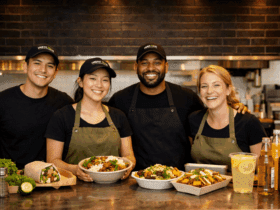Restaurants are important to society because they act as hubs where people can socialize, celebrate, and eat! By presenting a variety of cuisines, exhibiting regional flavors and creating a stage for culinary innovation, they have cultural value. There are 749,404 restaurants in the United States, as of 2023 thereby making it extremely competitive. Restaurants may frequently face a number of obstacles that might harm their profitability and performance.
In this article, we’ll look at five issues that restaurants frequently encounter and what solutions are available to overcome them.
Problem One: High Operational Costs
Restaurants frequently struggle to control expenditures, especially those related to food and drink, utility expenses and labor. Failure to keep costs under control might result in decreased profitability and even firm closure.
Solutions
Implementing inventory management systems: Regularly evaluate stock levels and put in place efficient inventory control procedures. Analyze the menu selections to find profitable and in-demand goods while removing ineffective ones. This can save waste, manage expenses, and increase profitability.
Put cost-cutting strategies into action: Look into energy-efficient equipment, bargain with suppliers for cheaper prices, and look for chances for bulk buying to cut costs. Additionally, to match labor expenses with client demand during slower times, think about optimizing employee levels.
Use of energy efficient appliances: Energy-efficient appliances aid in lowering energy usage, resulting in lower utility costs and cost savings for restaurant owners. These appliances maximize energy usage without sacrificing performance by leveraging cutting-edge technologies and designs.
Problem Two: Recruitment and Retention of Staff
Restaurants commonly struggle with staffing issues, such as high turnover rates, complicated hiring processes, and inadequate training. Research says, a staggering 75% of employees in the restaurant business leave each year and this number has been climbing since the pandemic. These problems may lead to inconsistent customer service, low employee morale, and higher operating costs.

Solutions
Creating a positive work environment: Foster an environment that values and supports employees by developing a positive workplace culture. Encourage open communication, offer incentives, and implement recognition programs to increase job satisfaction and lower turnover.
Offering competitive wages and benefits: Competitive pay and benefits draw and keep the best restaurant employees hence increasing output and job satisfaction. Competitive pay and benefit packages show that the restaurant values its staff members’ contributions and loyalty, which in turn encourages dedication and loyalty. Additionally, it boosts employee morale and job satisfaction, which enhances output and customer service.
Providing opportunities for growth and professional development: This would allow employees to enhance their skills, expand their knowledge and advance their careers within the restaurant industry. By offering training programs, mentorship, and opportunities for promotion, restaurants can cultivate a motivated and skilled workforce. Staff members who feel valued and supported in their professional growth are more likely to stay with the restaurant.
Problem Three: Managing Customer Expectations
Customer satisfaction can be negatively impacted by inconsistent food and service quality, which can also damage a restaurant’s reputation. Success depends on upholding a high standard of excellence in all parts of the eating experience.
Solutions
Execute routine quality assurance inspections: Implement quality control measures to frequently evaluate the quality of the meals and services. To find and quickly fix any problems, this can entail tasting dishes, conducting spot checks, and getting customer feedback.
Focusing on staff training and customer service: Keep lines of communication with the kitchen and service workers open and clear to make sure they comprehend and adhere to the stated quality standards. To preserve consistency and enhance processes, encourage employee feedback and provide quality training.
Regularly updating and innovating the menu: It’s vital that you take time to sit down and update your digital menu or old-school paper menu so that customers would always know what’s on the table. Added to that, it’s important that your restaurant keeps innovating and introducing brand new dishes to keep your customers on their tip toes!

Ensuring hygiene and cleanliness: In a restaurant, upholding cleanliness and hygienic standards is crucial. It guarantees the security and health of both customers and employees. A hygienic setting lowers the possibility of contracting a foodborne illness, guards against contamination, and enforces health laws. Additionally, a clean, aesthetically pleasing restaurant inspires trust in the caliber and professionalism of the business in its customers.
Problem Four: Increasing Competition in the Market
As mentioned right at the beginning, there are 749,404 restaurants in the United States, as of 2023 thereby making the restaurant industry extremely competitive. Hence, your restaurant would have to step up its game in order to be the red in a world of black and white.
Solutions
Finding a unique selling proposition: In today’s cutthroat economy, a restaurant must have a unique selling proposition (USP). A restaurant’s unique selling proposition (USP) is what makes it stand out from the competition and persuades diners to choose it over other dining establishments. It may be a specialty food, a particular cuisine, a unique setting, first-rate customer service, or an original idea. A compelling USP creates a distinct and memorable consumer experience that resonates with them, increasing visibility.
Implementing effective marketing strategies: A restaurant’s success depends on its ability to implement effective marketing techniques. Customers are attracted and kept, brands are established, and sales are increased. Restaurants can engage their target audience by using channels like social media, internet advertising, and collaborations. The management of online reviews and comments improves reputation, while exciting content, appealing aesthetics and promotions generate enthusiasm.
Utilizing social media platforms for promotion: In order to connect and interact with a big audience, social media has emerged as a crucial tool for restaurants. Restaurants may display their culinary masterpieces, offer information about specials and events, and communicate with customers directly by keeping active profiles on social media sites like Facebook, Instagram, and Twitter.

Problem Five: Adapting to Technological Changes
A restaurant’s growth might be hampered by a failure to adopt new technologies by reducing operational effectiveness, missing out on marketing opportunities and offering restricted consumer convenience. As the modern restaurant sector continues to grow and become more competitive, adopting technology provides simpler operations, expanded marketing opportunities, and greater customer experiences.
Solutions
Implementing restaurant management software: The efficiency of a restaurant’s operations can be greatly increased by the implementation of restaurant management software. This program has functions for managing inventory, POS (point-of-sale) systems, booking tables, staffing, and analytics. Restaurant management software simplifies operations, lowers manual errors, and saves time by automating these activities.
Online ordering and delivery platforms: Platforms for online ordering and delivery have grown in popularity and importance for restaurants. Through websites or smartphone apps, these platforms enable customers to conveniently order food for delivery or pickup. By enabling online ordering, restaurants may reach a wider audience and satisfy customers’ rising need for flexibility and convenience.
In conclusion, managing a prosperous restaurant does come with its difficulties. Restaurant owners and managers confront a variety of challenges, from high operational costs and workforce concerns to managing consumer expectations and growing competition. However, these difficulties can be overcome if the appropriate tactics and procedures are employed.
What are your thoughts about this engaging topic of interest?









Leave a Reply